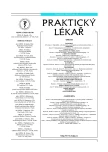Auricular fibrillation in everyday practice
Authors:
R. Stančík
Authors‘ workplace:
Kardiologická ambulance NsP, Nový Jičín, primář MUDr. V. Koziel
Published in:
Prakt. Lék. 2005; 85(1): 12-15
Category:
Of different specialties
Overview
Auricular fibrillation (AF) is the most frequent arrhythmia that cardiologists, internists and general practitioners encounter. Insufficiently treated, it significantly increases the mortality and morbidity of patients under this diagnosis. The most frequent shortcomings are in the prevention of thromboembolic events (namely little indicated anticoagulation therapy in patients highly under risk), not rarely also in an erroneous choice of anti-arrhythmic therapy or an insufficiently followed up ventricular response in unchecked AF. Besides the usual anti-arrhythmic therapy there are also non-pharmacological options of which catheter ablation has the greatest boom. According to results of clinical studies, the until recently preferred efforts to induce a sinus rhythm and its further maintenance, have not let to any substantial lowering of morbidity and mortality as against patients with AF left unchecked under conditions of consistent prevention of thrombo-embolic complications and an appropriate follow-up of the ventricular response. According to present-day recommendations the chosen strategy depends in the main part on an individual approach to the patient.
Key words:
auricular fibrillation – cardioversion – catheter ablation.
Labels
General practitioner for children and adolescents General practitioner for adultsArticle was published in
General Practitioner

2005 Issue 1
Most read in this issue
- Multiple osteolytic foci – a differential diagnostic approach (case report)
- Treatment of primary anorgasmia
- Lithiasis in otorhinolaryngology
- Responsiveness is one of the important objectives and criteria of quality in healthcare
